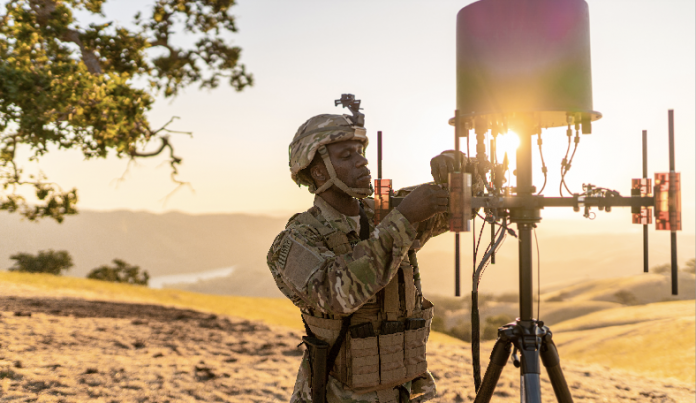Upcoming Events
Enhancing global security with innovative RF capabilities

Jackson White, Business Development Director of Tactical Data Links and VP Marketing, SPX Communication Technologies looks at the use of Unmanned Aerial Systems (UASs).
Global security has been on high alert in the last few years with heightened geopolitical and social tensions and evolving electronic warfare efforts all impacting the threat landscape at a rapid rate. Security and policing are seeing more incursions across borders and threats to critical national infrastructure, where billions of dollars of services are at risk.
In line with these trends, our teams at SPX Communication Technologies are having more and more conversations about the use of Unmanned Aerial Systems (UASs). These usually centre around two areas: combatting hostile use of UAS, and their ability to aid communications and intelligence gathering. In this context, successfully defeating any danger posed by errant, illegal or malicious UASs is becoming ever more critical for global security.
UAS for intelligence gathering
Recent years have emphasised how critical real-time Communications Intelligence (COMINT) is for defence, CNI and national security.
Teams increasingly must rely on instant, precise information from multiple sources to effectively address threats and make the smartest tactical and response decisions. The ability to record, receive, and stream real-time high-quality video and data is therefore critical for all defence, security, and policing organisations charged with securing their nation's population and Critical National Infrastructure (CNI).
Due to a shift toward Unmanned Aerial Systems, Tactical Data Link technology has increasingly been deployed to enable the transfer of critical data. As well as fixed and rotary-wing aircraft, drones are now able to conduct reconnaissance missions to support teams on the ground. Air-to-air transmission enables rapid, long-range data exchange with decision-makers, which has a direct impact on improving the tempo of tactical response.
In line with this trend, SPX Communication Technologies recently launched its enhanced data link encoder / decoder. The capability delivers improved low-latency, long-range, high-definition video and audio transfer for faster and more accurate intelligence-gathering across defence, security and policing organisations worldwide. The lightweight, low-power unit can be installed on manned and unmanned air platforms, providing real-time intelligence-gathering, incident response, and civilian safety.
The next generation Evenlode Video and Audio Encoder / Decoder’s high-efficiency video coding (HEVC) H.265 low-latency encoding delivers superior multi-video compression for efficient video recording and real-time, secure distribution. Latency below 120 milliseconds end-to-end means images are transferred and received in real-time, enabling greater situational awareness, and more accurate, faster response. 4K Ultra High Definition video ensures crisp image quality, making it easier to identify details and potential threats.
It significantly reduces the required bandwidth to transfer the same – or better – quality video and audio data than existing models in the market. Considering the limited Radio Frequency (RF) bandwidths available to defence, security and policing organisations, access to freed-up IP allows greater flexibility for sharing critical data through encrypted file shares. It also allows greater use of applications such as electro-optical/infrared sensors, and tracking and location data being shown on a moving map – all improving incident response.
The decoder mirrors the encoding capabilities, allowing the real-time re-streaming – or transcoding – to multiple destination points such as a command centre or at the tactical edge using mobile devices. This adds flexibility to users' video distribution aims in one single solution.
Combatting hostile use of UAS
Malicious actors are increasingly using UAS because of their flexibility, low cost, and capacity to be updated. Today, unmanned systems such as drones are considered one of the biggest threats to national safety, and their use is only intensifying. Radio Controlled Improvised Explosive Devices (RCIEDs) account for most military and civilian casualties in asymmetric warfare environments.
To help address this growing threat, we also launched an upgraded 953 Communications Intelligence (COMINT) Radio Frequency (RF) Receiver. The capability is designed for superior identification, direction-finding, and tracking of hostile RF signals to support COMINT and Counter-UAS tactical operations.
The new 953 COMINT RF Receiver builds on the success of its predecessor and now boasts reduced size and weight, but with greater power. This makes the device portable for dismounted operations and easily mounted on a vehicle to support mobility operations. For example, it can be carried to an elevated position in a dismounted role, such as a tactical position only accessible on foot or on top of a high-rise building, to ensure the antenna is situated at height for optimum signal detection and increased range.
The 953 COMINT RF Receiver performs continuous, unmanned, remote, and real-time signal collection up to 80MHz bandwidth across a frequency of up to 40GHz for signal monitoring, collection, and direction-finding. This bandwidth delivers a sweet spot between monitoring sufficient signal breadth and amplitude to ensure quality and accuracy in identifying threats.
As specialists in RF spectrum technologies that enhance COMINT and video and IP data transfer, we work very closely with defence teams to keep up with their needs and develop new solutions alongside them where they will make the greatest impact.
In 2024 SPX Communication Technologies – made up of TCI and ECS – will continue to build on its decades of experience to deliver sustainable and exceptional results to defence teams across the globe, while ensuring a smarter, more secure future for all.
Upcoming Events
digital issue












